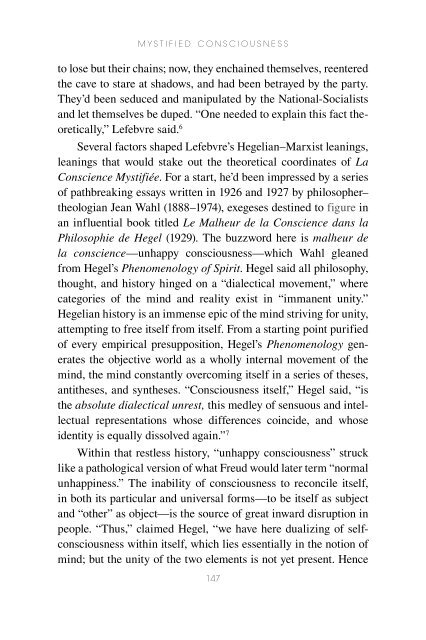Henri Lefebvre: A Critical Introduction - autonomous learning
Henri Lefebvre: A Critical Introduction - autonomous learning
Henri Lefebvre: A Critical Introduction - autonomous learning
You also want an ePaper? Increase the reach of your titles
YUMPU automatically turns print PDFs into web optimized ePapers that Google loves.
M y s t i F i e d c o n s c i o U s n e s s<br />
to lose but their chains; now, they enchained themselves, reentered<br />
the cave to stare at shadows, and had been betrayed by the party.<br />
They’d been seduced and manipulated by the National-Socialists<br />
and let themselves be duped. “One needed to explain this fact theoretically,”<br />
<strong>Lefebvre</strong> said. 6<br />
Several factors shaped <strong>Lefebvre</strong>’s Hegelian–Marxist leanings,<br />
leanings that would stake out the theoretical coordinates of La<br />
Conscience Mystifiée. For a start, he’d been impressed by a series<br />
of pathbreaking essays written in 1926 and 1927 by philosopher–<br />
theologian Jean Wahl (1888–1974), exegeses destined to figure in<br />
an influential book titled Le Malheur de la Conscience dans la<br />
Philosophie de Hegel (1929). The buzzword here is malheur de<br />
la conscience—unhappy consciousness—which Wahl gleaned<br />
from Hegel’s Phenomenology of Spirit. Hegel said all philosophy,<br />
thought, and history hinged on a “dialectical movement,” where<br />
categories of the mind and reality exist in “immanent unity.”<br />
Hegelian history is an immense epic of the mind striving for unity,<br />
attempting to free itself from itself. From a starting point purified<br />
of every empirical presupposition, Hegel’s Phenomenology generates<br />
the objective world as a wholly internal movement of the<br />
mind, the mind constantly overcoming itself in a series of theses,<br />
antitheses, and syntheses. “Consciousness itself,” Hegel said, “is<br />
the absolute dialectical unrest, this medley of sensuous and intellectual<br />
representations whose differences coincide, and whose<br />
identity is equally dissolved again.” 7<br />
Within that restless history, “unhappy consciousness” struck<br />
like a pathological version of what Freud would later term “normal<br />
unhappiness.” The inability of consciousness to reconcile itself,<br />
in both its particular and universal forms—to be itself as subject<br />
and “other” as object—is the source of great inward disruption in<br />
people. “Thus,” claimed Hegel, “we have here dualizing of selfconsciousness<br />
within itself, which lies essentially in the notion of<br />
mind; but the unity of the two elements is not yet present. Hence<br />
147
















